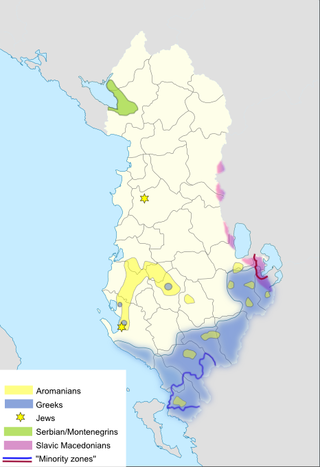Related Research Articles
The history of the Jews in Latin America began with conversos who joined the Spanish and Portuguese expeditions to the continents. The Alhambra Decree of 1492 led to the mass conversion of Spain's Jews to Catholicism and the expulsion of those who refused to do so. However, the vast majority of conversos never made it to the New World and remained in Spain slowly assimilating to the dominant Catholic culture. This was due to the requirement by Spain's Blood Statutes to provide written documentation of Old Christian lineage to travel to the New World. However, the first Jews came with the first expedition of Christopher Columbus, including Rodrigo de Triana and Luis De Torres.

Anu – Museum of the Jewish People, formerly the Nahum Goldmann Museum of the Jewish Diaspora, is located in Tel Aviv, Israel, at the center of the Tel Aviv University campus in Ramat Aviv. The Hebrew Anuאנו means 'we, us'.

The history of the Jews in Portugal reaches back over two thousand years and is directly related to Sephardi history, a Jewish ethnic division that represents communities that originated in the Iberian Peninsula. In the sixteenth and seventeenth centuries, Portuguese Jews emigrated to a number of European cities outside Portugal, where they established new Portuguese Jewish communities, including in Hamburg, Antwerp, and the Netherlands, which remained connected culturally and economically, in an international commercial network during the seventeenth and eighteenth centuries.

The history of the Jews in Indonesia began with the arrival of early European explorers and settlers, and the first Jews arrived in the 17th century. Most Indonesian Jews arrived from Southern Europe, the United Kingdom, the Netherlands, Belgium, Germany, France, the Middle East, North Africa, India, China, and Latin America. Jews in Indonesia presently form a very small Jewish community of about 100–550, of mostly Sephardi Jews. Judaism is not recognized as one of the country's six major religions, however its practices are allowed under Perpres 1965 No. 1 and article 29 paragraph 2 of the Constitution of Indonesia. Therefore, members of the local Jewish community have to choose to register as "Belief in One Almighty God" or another recognized religions on their official identity cards.

The history of the Jews in Albania dates back about 2,000 years. According to historian Apostol Kotani : "Jews may have first arrived in Albania as early as 70 C.E. as captives on Roman ships that washed up on the country's southern shores... descendants of these captives that would build the first synagogue in the southern port city of Sarandë in the fifth century...[but] Little is known about the Jewish community in the area until the 15th century."

Merkos L'Inyonei Chinuch is the central educational arm of the Chabad-Lubavitch movement. It was founded in 1943 by the sixth Rebbe, Rabbi Yosef Yitzchok Schneersohn, who served as president, and appointed his son-in-law, Rabbi Menachem Mendel Schneerson, who would later become the seventh Rebbe, as its chairman and director. After the passing of Rabbi Yosef Yitzchok Schneersohn, Rabbi Menachem Mendel Schneerson succeeded him as president. Today, Rabbi Chaim Yehuda Krinsky serves as chairman and [until his death in 2024] Rabbi Moshe Kotlarsky A"H served as vice-chairman.

The Sephardic Jews that were exiled from Spain and the Mediterranean area in 1492 and 1497, coupled with other migrations dating from the 1700s and during World War II contributed to Dominican ancestry.

The History of the Jews in Amsterdam focuses on the historical center of the Dutch Jewish community, comprising both Portuguese Jews originally from both Spain and Portugal and Ashkenazi Jews, originally from central Europe. The two separate groups have had a continuing presence since the seventeenth century. Amsterdam has been called a Jerusalem of the West and the "Dutch Jerusalem". The Holocaust in the Netherlands devastated the Jewish community, with the Nazis murdering some 75% of the approximately 80,000 Jews at time present in Amsterdam, but the community has managed to rebuild a vibrant and living Jewish life for its approximately 15,000 present members.
The history of the Jews in Omaha, Nebraska, goes back to the mid-1850s.

The history of Jews in Thailand began in the 18th century with the arrival of Baghdadi Jewish families and Jewish peoples from Europe during the Napoleonic era (1799–1815).

Beth Israel Synagogue is the synagogue of the Aruban Jewish community, located in Oranjestad, Aruba. Beth Israel Synagogue is an independent congregation with a liberal style similar to Reform Judaism or Conservative Judaism.
The history of the Jews in Vancouver in British Columbia, Canada has been noted since the mid-19th century.
The history of Jews in South Florida dates back to the 19th century. Many South Florida Jews are Ashkenazi, and Latin American. Many are also French, Moroccan, Syrian, Bukharan, and Israeli. There is a significant Sephardic and Mizrachi population as well.

The history of the Jews in the Democratic Republic of the Congo can be traced back to 1907, when the first Jewish immigrants began to arrive in the country. The current Jewish Congolese population is mostly of Sephardi background.
The history of the Jews in Curaçao can be traced back to the mid-17th century, when the first Jewish immigrants began to arrive. The first Jews in Curaçao were Sephardi Jewish immigrants from the Netherlands, Portugal, and Spain. These immigrants founded Congregation Mikvé Israel-Emanuel, the oldest continuously used synagogue in the Americas. The first Jew to settle in Curaçao was a Dutch-Jewish interpreter named Samuel Cohen, who arrived on board a Dutch fleet in 1634. By the mid-1700s, the community was the most prosperous in the Americas and many of the Jewish communities in Latin America, primarily in Colombia and Venezuela, resulted from the influx of Curaçaoan Jews.

The Jewish community of Houston, Texas has grown and thrived since the 1800s. As of 2008, Jews lived in many Houston neighborhoods and Meyerland is the center of the Jewish community in the area.
The history of the Jews in Central Asia dates back centuries, where Jews have lived in countries which include Kyrgyzstan, Kazakhstan, Tajikistan, Turkmenistan, and Uzbekistan.

The Jewish community of the Greater Cleveland area comprises a significant ethnoreligious population of the U.S. State of Ohio. It began in 1839 by immigrants from Bavaria and its size has significantly grown in the decades since then. In the early 21st century, Ohio's census data reported over 150,000 Jews, with the Cleveland area being home to more than 50% of this population. As of 2018, Greater Cleveland is the 23rd largest Jewish community in the United States. As of 2023, the Cleveland Jewish Community is estimated to be about 100,000 people.
The history of the Jews in Alaska began before the Alaska Purchase in 1867. Jews from Imperial Russia lived there periodically as fur traders, and a Jewish community has existed since the 1880s. The Klondike and Nome gold rushes attracted Jews to Alaska to seek their fortunes as miners and businessmen and resulted in the first organized Jewish communities. In the Nazi period, Jewish refugee resettlement in Alaska was seriously considered by the government, but after facing backlash, never came to be. Alaskan Jews played a significant role in business and politics before and after statehood, and have included mayors, judges, senators and governors. Today, there are Jews living in every urban area of the state.
References
- ↑ "The Jewish Community of Aruba". The Museum of the Jewish People at Beit Hatfutsot.
- ↑ "The Jewish Community of Aruba". The Museum of the Jewish People at Beit Hatfutsot.
- ↑ "Curaçao". Jewish Virtual Library . Retrieved 2013-11-02.
- ↑ "Aruban P.M. Welcomes Future Rabbis to Caribbean". Chabad.org/News. Retrieved 2014-06-18.
- ↑ "Aruba Jewish community". Beth Israel Synagogue. Archived from the original on 2013-11-04. Retrieved 2013-11-02.